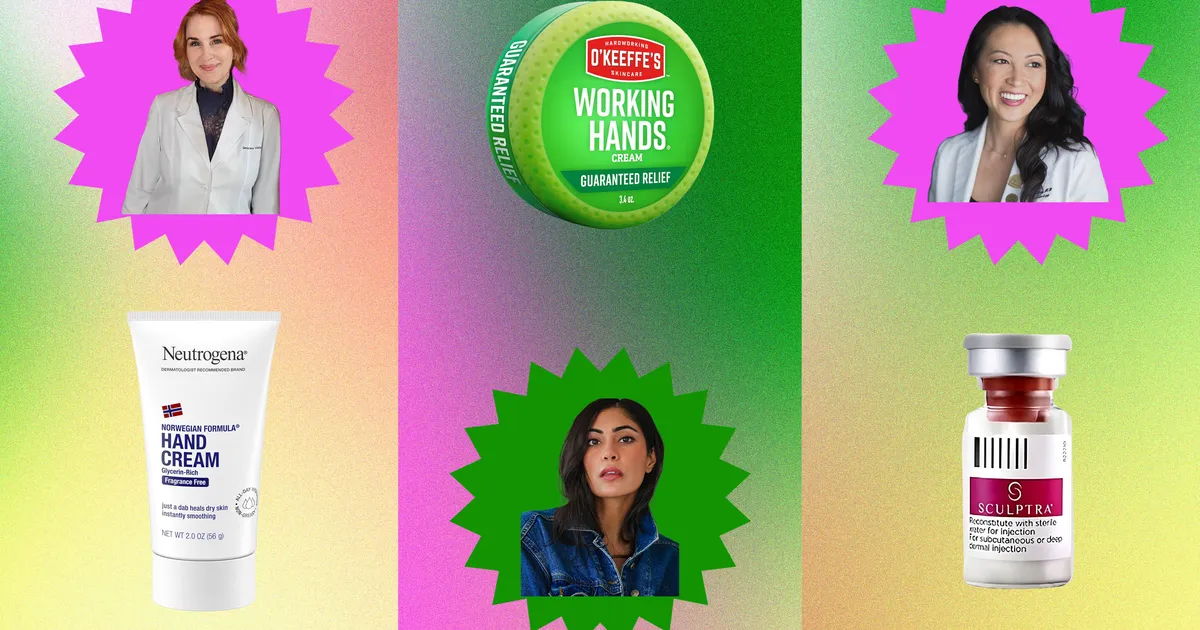Copyright New York Magazine

Welcome to Wrinkles Week on the Strategist, where we’re deeply vetting skin-care solutions for anyone who’s looking to smooth fine lines and wrinkles (or prevent them from showing up in the first place). For more, head to our Wrinkles Week hub. Whether it’s talking through some odd new ingredient we’ve spotted or hashing out the current status of blush, Strategist beauty writers and editors make some of our best discoveries as a team. It all works so well that we decided to loop some of our favorite beauty experts into the conversation, too. For this edition, Strategist beauty writer Dominique Pariso chatted with dermatologist Dr. Aegean Chan, nurse practitioner and New York State licensed aesthetician Genevieve Vielbig, and Divya Sethi, founder of Flawless Hand Models, a bicoastal modeling agency based in Los Angeles and New York, about anti-aging on an area we often neglect: the hands. Below, we discuss driving gloves, what in-office treatments aren’t worth it, and the importance of SPF. Dominique Pariso, writer: We often hear that our hands give us away when it comes to aging. I wanted to start off by asking why our hands tend to show our age faster than other parts of the body? Genevieve Vielbig, nurse practitioner and New York State licensed aesthetician: Thinner skin and they’re often exposed to the elements. Dr. Aegean Chan, dermatologist: And I think people really neglect that area. People are a lot more intentional about how they expose their facial skin and they put more care into protecting their faces with sunscreen. So your hands are just getting more UV exposure, even in small doses: The hour you’re out running around doing errands, you’re still getting UV exposure. So in addition to that thinner skin, there’s unintentional neglect. I would say the chest is also an area that a lot of people neglect as well. Divya Sethi, founder of Flawless Hand Models: Clothes cover the rest of our body. But what are the areas that are most exposed? Our face, our neck, and our hands. The face is kind of top priority. But who’s really putting sunscreen on their hands? A.C.: Even as a dermatologist, I’m guilty of that too. I’m putting sunscreen religiously on my face every single day, and I’m not as consistent on my hands. And I think if you’re washing your hands, you’re putting hand sanitizer on throughout the day, it’s just a lot harder to be consistent with that. D.P.: What are some of the areas of concern people have when it comes to their hands? G.V.: A lot of times people will see brown spots and they’ll freak out about that. And then they’ll start to see the volume loss, because they’ll start to see their tendons and their veins. And then the texture. Dr. Chan, do you agree with that? A.C.: I definitely agree, and I will point out that it comes up a lot later. I think that people are noticing these changes at a later state than they notice it on their face. A lot of times it’s patients in their 60s and 70s when it’s a lot harder to treat. When we talk about treatment options and what end results that they can expect, that conversation becomes a little bit thornier. D.P.: So if we’re talking about prevention, is there a particular at-home routine people should be implementing, the sooner the better? And if so, what would you guys recommend? G.V.: SPF. A.C.: Definitely echoing what Genevieve said — SPF. Prevention is worth its weight in gold. You can’t turn back the clock. No matter how many procedures you’re doing, no matter how many actives you’re putting on, it’s never going to be as good as if you prevented that UV damage in the first place. But SPF is actually the least reliable way to protect your skin from UV. I think because you have to put it on, you have to put on a thick enough layer. If you’re putting a dab on, you’re not getting the SPF that’s on the bottle. You’re getting a fraction of that. So I always like to emphasize more physical protection. Especially if you’re spending a really long time outside. I really like that there’s a lot more UPF clothing that have the thumb loops and the extended sleeve that really cover the dorsal hands. Obviously, then you’re not getting that coverage on the finger. But I do think the finger skin tends to be a little thicker, so you don’t get as much of that atrophy and that thinning of the skin. It’s not as apparent as the back of the hands. I also recommend gloves. Driving gloves are becoming more common. D.P.: They’re sort of chic, right? D.S.: I have driving gloves. Saved View Want to be emailed when products you’ve saved are over 20% off? Success! You'll get an email when something you've saved goes on sale. Yes New! You can now save this product for later. A.C.: And then with UV-light exposure, we have to talk about nail treatments. I think that can become cumulative, too, and can definitely accelerate that UV aging and the skin changes we see. D.P.: On the topic of nail care, would you then recommend regular manicures and maybe taking it easy on the UV gel manicure? D.S.: Our models are strictly told, “No tips, no acrylics, and ideally no gel.” That’s something that we’re very adamant on, because it destroys your nail beds over time. And I think a sign of healthy, youthful hands is your nails. So I like to keep them as bare as possible. I know a lot of women would totally disagree with me on that, but in my profession, it’s important that the nails are well taken care of. If you have polish on, give your nails some time to breathe in between manicures. I also recommend using cuticle oil. But if you’re working on strengthening your nails, you can’t necessarily keep them bare because they’ll break pretty easily. In which case there’s OPI Nail Envy, a polish that can strengthen your nail beds in the beginning. D.P.: I was wondering if each of you wanted to talk me through your hand-care routines. Divya, I imagine yours might be the most intense. Or if I’m about to out everyone as also being negligent, that’s okay. [Laughs.] D.S.: Whatever is going on my face is also going on my hands. Vitamin C in the mornings, hyaluronic acid in the evenings. I am big on SPF on the hands. However, as we mentioned, it’s annoying because we’re washing our hands all the time, so you’re going to be washing all the SPF off. I have one of those sunscreen sticks that I keep in my bag. I’m just reapplying it all day. I also like to do red-light therapy. It makes me feel like I’m doing something. I get the question all the time: “What do you do to keep your hands soft?” I personally avoid most moisturizers. I’m of Indian descent, and I’m sure you guys are very familiar with oils in Indian culture. So my go-to for my whole body is almond oil. I love almond oil; I’m obsessed with almond oil. Any 100 percent cold-pressed sweet-almond oil is great. I typically pick mine up from a local Indian store. I put it all over my body after a shower every evening. If you were here, if we were in person, I would make you guys touch my hands and my arms. I pride myself on being super-moisturized, and almond oil is my go-to. D.P.: I feel like I can see how soft they are through the camera. A.C.: Divya, you’re very soft. It’s aspirational. I have three young children, so I can’t do anything. I like that tip: Whatever you’re putting on your face, whatever’s excess, just rub a little on your hands, especially actives like a retinoid. The hand skin is going to be more tolerant, too, so you could sort of blast it a little bit more with actives. As long as you don’t have eczema or other underlying barrier issues going on. As a dermatologist, I think oils work for some people, but I do think that some people find that their skin gets dry pretty shortly after applying oils. It depends on your environment and your skin type. Me personally, and for a lot of my patients, I like the glycerin-heavy products. The hands can get so dry, so easily. Glycerin-heavy products tend to keep the hands more moisturized for a longer period of time. Like the Neutrogena Norwegian hand cream, that’s one of my favorites. It’s super glycerin-heavy. O’Keeffe’s Working Hands, especially as we get into the winter months, a lot of people get dry cracked hands or hand dermatitis or eczema. Those types of products tend to help retain moisture because glycerin does pull water in as a humectant. And then there’s other occlusive ingredients, so I do find for my patients that that helps at keeping your hands soft and helping retain moisture throughout the day. My other tip is to keep a moisturizer by your sink. So every time after you wash your hands, get in the habit of dabbing a little bit of that moisturizer on your hands and rubbing it into your cuticles. I think a lot of people just do it once a day at night before they go to bed. But because our hands are getting so much exposure to the environment and potential irritants, it’s important to reapply throughout the day. Saved View Want to be emailed when products you’ve saved are over 20% off? Success! You'll get an email when something you've saved goes on sale. Yes New! You can now save this product for later. Saved View Want to be emailed when products you’ve saved are over 20% off? Success! You'll get an email when something you've saved goes on sale. Yes New! You can now save this product for later. Neutrogena Norwegian Formula Hand Cream - 2 oz $6 for 6 $7 now 14% off $6 for 6 G.V.: Dr. Chan, glycerin was your go-to, but what do you think about ceramides for the hands? A.C.: I think all of these work in concert. If you’re thinking about skin barrier, you need several things from the bucket: You need the glycerin to really pull in the water, you need occlusive ingredients, like a mineral oil, petrolatum, shea butter, and then you need ceramides, which are emollients to soften the skin. D.P.: Genevieve, what about your routine? G.V.: During the day, I use moisturizer. At night, I’ll rotate between retinol and then I also use estrogen cream, for the ladies that are in perimenopause. I usually use it as my eye cream, and I use it as my hand cream to thicken the back of the dermis back here. Not for everybody, but if you’re a certain age, then definitely the estrogen cream is really helpful. D.P.: What type of retinol do you use? G.V.: I do the 0.25 tretinoin. I usually give that as a prescription to most patients. If they want an over-the-counter option, then I recommend Skinbetter’s AlphaRet. That’s a good one. Saved View Want to be emailed when products you’ve saved are over 20% off? Success! You'll get an email when something you've saved goes on sale. Yes New! You can now save this product for later. D.P.: I like that one, too. G.V.: I’ve also had a lot of fillers in my hands, and they still look like they could use more. A.C.: The hands need so much filler. G.V.: It is insane. A.C.: Are you doing Sculptra or general Radiesse? G.V.: I started with hyaluronic just because I was nervous, and then I switched to Radiesse. So the Radiesse seems to be better just to help with the skin texture. I grew up in California, so I had a lot of sun exposure when I was younger. And as a Caucasian woman with no melanin in my skin, plus perimenopause, menopause, I can see the skin changing rapidly. It’s kind of insane. So even with a lot of filler in the hands, you can still see my tendons and my veins. And then for the texture, I’ve done broadband laser IPL. I’ve done Fraxel a few times, and I’ll do it again this winter. I’ll just keep fucking burning it off. A.C.: I was going to say, have you done some fractional non-ablative, fractional ablative like Erbium or CO2? G.V.: So in order to do the CO2, I have to take days off, because I have to wear gloves every day. Fraxel’s a little easier to recover from. I actually just got an Erbium. So maybe we will take a few days off after Christmas and have weird hands. D.P.: By texture, do you mean rough or do you mean crêpey? G.V.: Crêpey. I look down and it looks like old-lady hands. A.C.: I think we’re all in different phases of life. I just turned 40 and I am just now seeing that crêpiness. There’s a little more laxity. I’ve actually not done any aesthetic treatments on my hands, but I’m like, Oh, maybe this winter’s the time for me to do a little Erbium laser. D.P.: For in-office treatments, is there anything that you think doesn’t usually work? G.V.: I don’t like microneedling for the hands. I don’t think it works for the hands. Dr. Chan, what do you think? A.C.: Yes. You don’t have hair follicles on the back of your hands. The areas that have the best healing are the areas that have the densest hair follicles, because that re-epithelialization process, those new skin cells migrating out, comes from your hair follicles. And the microneedling depends on that re-epithelialization. You’re going to get better results with laser. But you have to be careful on the back of the hands. The healing is just less robust because the skin is also thinner. Especially if you have skin of color, the risk of scarring is higher. And we briefly touched on fillers, too. So you could use hyaluronic acid fillers or the more collagen-stimulator fillers. So Radiesse, the calcium hydroxyapatite, or Sculptra, the polylactic acid, those stimulate the collagen. But you can’t reverse it. So if you’re nervous and you’re newbie to fillers, you probably want to stick to the hyaluronic acid initially. But I think in the right hands with the right practitioner, I think you get the most natural results with the collagen-stimulating fillers. Especially if you’re sort of older and you are seeing a lot more of that atrophy, you see a lot of the veins and the tendons, and you want to increase the volume, filler would be the way to go. G.V.: Do you think that Sculptra is one of your choices for back of the hands? A.C.: Some people do Sculptra. I personally use Radiesse more. D.P.: Thank you all your time. Any last words? A.C.: Sunscreen. You can use the same actives from your face on the back of your hands. And get driving gloves. More From The Strategist The Best Clean Anti-Aging Skin-care Routine, According to Experts An Advent Calendar for Every Kind of Person The Best in Class Hall of Fame I Own 20 Pairs of Loafers. These Are the Ones Worth Buying. See All



